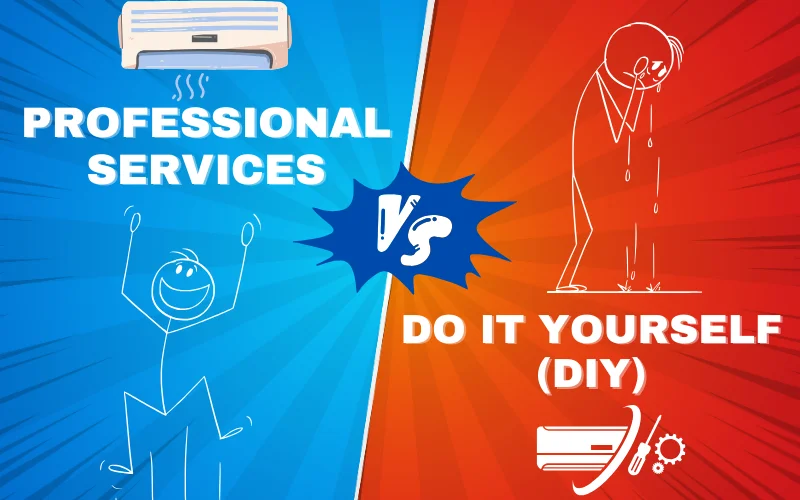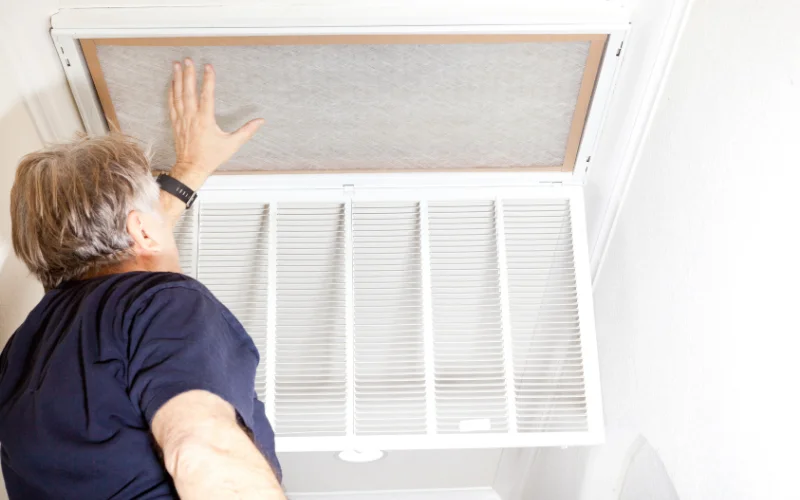- 04-254-5445 / TOLL FREE - 800 (BLUE) 2583
- Info@bluediamondfm.com

Considering professional vs DIY duct cleaning? Discover the safest, most effective route to cleaner indoor air. Weighing upfront costs, equipment limitations, and long-term benefits ensures your decision aligns with your home’s unique needs.
Tired of dust and allergens circulating from your home’s air ducts? You know it’s about time to clean them, but should you call the pros or tackle it as a DIY project?
If you’re on the fence deciding between professional vs. DIY duct cleaning, you need to weigh a few key factors first beyond the upfront cost. The quality of the air your household breathes daily hangs in the balance.
We clear the confusion around duct cleaning methods to help determine the safest route for your needs. Get ready to breathe easier as we explore realistic costs, equipment limitations, contamination risks, and hidden longevity benefits that impact your decision.
Get the facts so you can stop second guessing whether to grab duct cleaning coupons from your local HVAC Company or DIY supplies from the hardware store.
Read to learn if you should leave duct cleaning to the qualified pros or if a weekend DIY project may suffice based on your scenario. Investing a few minutes now saves you money, health hazards, and cleanup headaches for years down the line!
Deciding between professional and DIY duct cleaning depends on factors like cost, equipment, safety, and desired outcomes. While DIY methods may save money upfront, professional cleaning ensures superior contaminant removal, enhanced air quality, and long-term benefits for your home.
Getting your air ducts professionally cleaned every 3-5 years as part of your HVAC system maintenance is highly recommended for optimal home air quality and performance.
Reputable duct cleaning companies have the high-powered equipment, products and training to thoroughly clean your entire ductwork from start to finish. This removes up to 98% of contaminants lurking in your ventilation system.
Benefits of professional duct cleaning services include:
1 Access & Clean Entire System:
Commercial vacuum units can reach every nook and cranny including flex duct runs, rigid metal trunk lines, registers, intakes and other components. This enables full contaminant removal. DIY efforts only clean 25-30% of most systems.
2 Sanitize & Deodorize:
Professional duct cleaners use advanced HEPA air scrubbers along with EPA-registered sanitizing products and deodorizers safe for your ducts and home. This eliminates mold, bacteria and bad ventilation odors.
3 Clear Blockages & Improve Airflow:
Over time, dust buildup and debris can impede proper airflow and reduce your HVAC system’s efficiency. Pros have specialized tools to clear out blockages and restrictions for better air volume and circulation.
4 Find & Fix Hidden Dangers Early:
In addition to improving your indoor air quality, a professional duct inspection can uncover concealed mold growth, clogs and serious HVAC issues before expensive damage occurs. Early mold detection and eradication helps prevent major repairs and potential duct replacement later.
While DIY duct cleaning may seem like an easy cost-effective option, there are considerable downsides to be aware of before grabbing consumer cleaning products off the shelf.

1 Limited Access:
Consumer wet/dry vacuums, small duct brushes and other DIY tools only reach straight, low-hanging duct sections near vents and registers. The majority of residential ductwork runs concealed in walls, floors and ceilings where contamination builds unchecked.
2 Ductwork Damage:
It’s easy to accidentally puncture flexible or rigid ducts, disconnect joints and fittings or otherwise impair your duct integrity using stiff brushes and improper tools. This leads to leaks, blockages and the need for premature duct repairs or replacement.
3 Spreading Contaminants:
Aggressive DIY attempts often stir up bio-contaminants and redistribute dust deeper into the system rather than safely containing and removing it. Breathing in stirred particulates worsens allergy and asthma symptoms.
4 Inability to Fully Sanitize:
While DIY efforts may temporarily clean visible contamination, they lack commercial-grade sanitizers and deodorizers to treat hidden bacteria and odors that quickly re-accumulate after amateur cleaning attempts.
5 Missing Hidden Problems:
DIY cleaners can’t properly inspect for concealed mold, clogged airflow components or serious HVAC issues that professional assessors catch early. Undetected moisture damage and mold growth inevitably means pricier remediation/repairs down the road.
Here is a table comparing professional vs. DIY duct cleaning:
| Professional Duct Cleaning | DIY Duct Cleaning |
| 1 Cost | |
| – $500 – $1000+ on average | – $50 – $150 for supplies |
| 2 Equipment | |
| – Commercial grade vacuums | – Consumer wet/dry vacuums |
| – High powered duct cleaning tools | – Small DIY brushes |
| – Truck mounted power washing systems | – Hardware store gear |
| 3 Cleaning Process | |
| – Access entire duct system | – Only visible/straight ducts |
| – Multi-step cleaning method | – Basic single pass scrubbing |
| – EPA approved disinfectants | – No commercial disinfectants |
| 4 Results | |
| Removes up to 98% of contaminants | Cleans approx. 25-30% of HVAC system |
| Fully sanitizes & deodorizes | Fails to sanitize unseen mold & bacteria |
| Improves home air quality long-term | Ducts quickly become decontaminated |
| Averts future HVAC issues | Risks stirring & spreading contaminants |
| Overall Value | |
| Higher upfront cost with long term payoff | Lower initial cost with poor IAQ results |
If attempting DIY ductwork cleaning, following proper safety precautions helps minimize risks of duct damage, spreading contamination further or harming your HVAC system.
1 Turn OFF Power to HVAC System
Locate the breaker/switch that controls your heating and cooling system power. Cutting power avoids electrical hazards and component damage if water penetrates live parts.
2 Use Protective Gear
Wear goggles, gloves, an N95 mask and coveralls when DIY cleaning to avoid direct contact with stirred particulates and chemicals.
3 Utilize Duct Brush
Only use a specialty duct brush to dislodge debris, never your hands or other tools that could puncture ductwork. Scrub gently to avoid leaks.
4 Keep Water Away From System
Avoid wet cleaning methods and take precautions to keep drips, leaks or condensation away from interior HVAC components and home interior spaces.
5 Cap Open Ducts
Any disconnected vents, registers or open duct ends should be promptly capped/ covered with plastic sheeting after cleaning to avoid recontamination.
Safety should be the number one priority if taking a DIY route. Anything short of extreme care risks health hazards and/or damage requiring professional repairs. Hiring experts is still the safest bet!
While regular preventative duct cleaning every 3-5 years is recommended for all homes, relying on pros is particularly advisable in certain situations:
1 Existing Mold Issues
If dealing with a known mold problem, leave eradication to professional remediates to contain spread and safely eliminate all fungal contaminants.
2 Recent Renovations
New construction and remodels release high levels of drywall dust, vocs, and debris into duct systems. Pro cleaning removes remnants.
3 Routine maintenance
To keep your HVAC system running efficiently over years of use, add professional duct cleaning to your seasonal home maintenance routine.
4 New Home Inspections
Uncover any latent construction debris or quality issues in your ventilation system with a professional ductwork inspection and cleaning service.
5 Musty Smells
If you notice odd vent odors despite replacing HVAC filters, professional duct cleaning, sanitizing, and deodorizing treatments can freshen indoor air.
6 Health Conditions
Households with members who have allergies, asthma, chemical sensitivities or comprised immune systems see the most benefit from keeping ducts contaminant-free.
In many situations, the potential repairs and medical bills avoided make professional duct cleaning services well worth the cost. Safety and health take priority.
While saving money doing it yourself can be tempting, most DIY duct cleaning attempts fall short in vital ways:
1 Using Bare Hands
Never directly touch contaminated duct surfaces with unprotected hands as this disturbs and spreads particulates you later breathe. Always use a duct brush tool.
2 Failing To Cut Power
Neglecting to turn off HVAC system power risks electrical malfunctions and water damage to interior components when moisture inevitably contacts live parts.
3 Wetting Indoor Areas
Allowing dripping water or condensation into interior walls/spaces promotes mold growth and structural damage requiring expensive professional mitigation.
4 Dislodging Debris Inward
Overaggressive DIY scrubbing often knocks contaminants deeper into system rather than safely containing it for removal. This worsens IAQ.
5 Spreading Contaminants
Inadequate DIY duct cleaning techniques stir up and redistribute dust and debris instead of fully eliminating it from your home’s air supply.
6 Inability to Fully Clean & Sanitize
Without commercial cleaning power and EPA antimicrobials, DIY efforts cannot properly eliminate bacteria, mold, allergens or ventilation odors. Most contamination remains unseen.
While DIY duct cleaning may seem like an easy way to save money, the limitations leave homeowners with subpar IAQ, recurring clogs and allergens, potential HVAC damage and inevitable recontamination. Getting the job done right the first time by the experts protects your home and health long-term.
Frequently Asked Questions – Professional vs DIY Duct cleaning
The most effective duct cleaning method is professional cleaning using high-powered equipment and specialized techniques. Their expertise ensures deep clean, removing dirt and allergens to enhance indoor air quality effectively
Yes, you can clean your air ducts yourself, but it’s often recommended to hire professionals for thorough cleaning.
Pros of air duct cleaning include improved indoor air quality and energy efficiency, while cons may include cost and potential damage to ducts.
The most commonly used method for the design of ducts is the radial method, which involves branching ducts from a central point.
Duct cleaning can potentially increase airflow by removing blockages and buildup, but it depends on the condition of the ducts.
conclusion
When it comes down to it, professional duct cleaning beats DIY efforts hands down if you want true, lasting results.
Sure, grabbing some brushes and vacuum attachments from the hardware store may save you a quick buck compared to hiring pros. But you risk leaving behind hidden health hazards and efficiency issues inside your home’s ductwork in the process.
Do it right the first time by calling the HVAC experts to deep clean, sanitize, deodorize and maintain your system. Have peace of mind knowing your family won’t keep inhaling irritating dust, debris, mold and allergens circulating from room to room each day.
Invest in professional-grade tools, products and multi-step duct cleaning, instead of just crossing your fingers that a quick DIY scrubbing will suffice.
Contact a top local air duct cleaning company and breathe easier once every last vent and register flows fresh, purified air again. With accessible financing options and 100% satisfaction guarantees, you get back every penny’s worth hiring the pros to keep your whole home’s ventilation contaminant-free once and for all
Blue Diamond Group Is Recognized as a Leading Facilities Service Provider in UNITED ARAB EMIRATES.
Head Office: MJM Al Ansari Building, Port Saeed, Deira, Dubai.
Blue Diamond Group 2024All Rights Are Reserved.
ISO CERTIFIED COMPANY 9001, 14001, 45001, 41001.
Get in touch with us